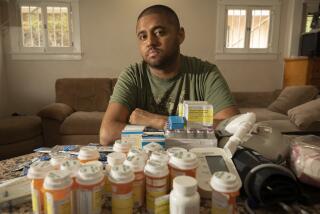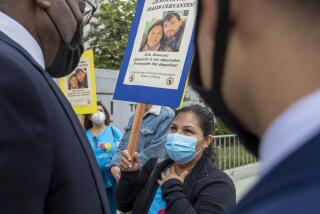Safety Net for Malpractice Has Fewer Holes in Europe : Health: Victims of medical tragedies get extensive social services. In U.S., lawsuits are often only recourse.
AMSTERDAM — Ron Fransen was clinically dead the moment he was born four years ago in a hospital near Amsterdam. His heart had stopped beating during his birth--the fault of the hospital, according to his parents--and even though he was revived, he suffered brain damage that prevents him from standing, sitting or even crawling.
Terrible though Ron’s tragedy was, the Dutch social security system helped his family make the best of it. At no direct expense to his family, the handsome, tow-headed boy receives six hours of specialized care every weekday; even the $50 taxi ride to and from the day-care center is free to the Fransens.
The contrast with the American practice could scarcely be sharper. In the Netherlands, as in most Western European countries--but emphatically not in the United States--Ron and other victims of medical catastrophes fall into a tight social safety net that provides the best medical, educational and social services available, largely at the expense of compulsory national insurance systems.
The expense is enormous. Dutch workers, for example, pay up to 60% of their earnings in taxes, and government social programs consume up to twice as much of the national wealth in some European countries as in the United States.
So costly has its social security system become that the Netherlands, like many of its European neighbors, is seeking ways to cut it. Ron Fransen’s day-care center has notified his family that it may have to begin footing part of the bill for Ron’s training.
Nor does the system come effortlessly. The Fransens had to battle an inflexible bureaucracy to get many of the benefits to which Ron is entitled. And they are seeking malpractice damages against the hospital to cover expenses that fall outside the Dutch social security system. Their goal is about $2 million, which could be the biggest malpractice award in Dutch history.
Yet for all the obstacles facing the Fransens, their plight would probably have been many times more serious in the United States. What is available through European social security systems can be obtained in the United States only from the courts. Multimillion-dollar malpractice awards are often the victim’s only recourse.
Consider the case of Valerie Castro, a 10-year-old Ventura County girl. When she was 2, Valerie emerged blind and partially disabled from surgery designed to remove scar tissue left from complications at birth. With no special help available to her, she still cannot read.
“If they had started her off with special educational aids when she was 3 or 4 or 6, when she really needed it, she would have learned Braille by now,” said her mother, Lorrain. “The public school does not have those things she needs. We couldn’t do more than what the school gave her.”
They may now be able to do a little more. The Castros won a $27-million malpractice award last July from Childrens Hospital in Los Angeles. But while the first $28,000 was scheduled to be paid within six months of the award, most of the money will not be available until after Valerie turns 18. All these millions, however, will do nothing to bring back the precious learning opportunities that Valerie lost in the last eight years.
And Valerie Castro is one of the lucky Americans who prevail in court. Many victims of medical mistakes come away with nothing.
“We see the American system as a kind of a lottery,” said Carel Stolker, a law professor specializing in malpractice at the University of Leiden in the Netherlands. “Some victims win big, and some get nothing at all.”
Americans file malpractice claims at a yearly rate of about one claim per seven doctors, according to Gary T. Schwartz, a UCLA law professor. That is about five times the rate in Britain, for example.
To protect themselves, American doctors paid an average of about $16,000 each for malpractice insurance in 1988, compared with $1,700 in Britain. Those costs, of course, are ultimately passed along to patients.
Joseph Newhouse, a professor of health policy at Harvard, figures that malpractice insurance accounts for about 2% of U.S. medical costs. He estimates that “defensive medicine”--unnecessary tests and other procedures undertaken by doctors purely to fend off potential malpractice claims--adds 1%. These percentages may seem small, but they represent one reason that Americans spend so much more than Europeans for their health care.
Why are Americans, compared with Europeans, so much more likely to go to court? The reasons have to do with the very different legal and social systems on the two sides of the Atlantic.
In the United States, the threat of huge malpractice judgments is considered one way of making sure doctors take all necessary precautions.
Europe relies on other ways of punishing doctors who make mistakes. Fortunately for the medical profession, the threat has eased substantially in the nearly 40 centuries since Hammurabi, the king of ancient Babylon, specified in humankind’s oldest known legal code that doctors who cost their “well-bred” patients their lives or eyesight should have their hands cut off.
Now it is only doctors’ careers that can be severed. Here in the Netherlands, where doctors must be certified every five years, boards of physicians and judges are empowered to fine or suspend doctors they find guilty of inadequate or slipshod practice.
Also at work are the two continents’ divergent approaches to the practice of law.
U.S. malpractice lawyers frequently work for contingency fees. If they lose, they are paid nothing; if they win, they receive a share--perhaps one-third--of the court award. Without such a system, many American lawyers argue, most malpractice victims would not be able to go to court at all.
Here in Europe, many lawyers regard contingency fees as unethical. They say lawyers should be paid according to the amount of work they do, not the size of the award they happen to win. Their pay comes largely from whichever side loses--either their own client or the doctor or the hospital they sue.
John Beer, the Amsterdam lawyer who represents the Fransen family, expects to be paid at an hourly rate, with the costs borne by the insurance company for the hospital where Ron Fransen was born. His pay will have nothing to do with how much money the Fransens ultimately collect.
If the Fransens fail to reach a settlement with the hospital and eventually go to court, the case will be decided, as it would throughout Europe, by a panel of judges.
In the United States, by contrast, it is juries of ordinary citizens who determine responsibility and set the size of awards. Juries are notoriously more sympathetic than judges to victims of doctors’ errors, and they are more likely to approve huge awards on the theory that doctors are insured anyway.
When U.S. juries compute damages, they typically do not take into account any benefits the victim might receive from an employer’s sick-leave plan or the Social Security disability program. European judges are required to reduce malpractice awards according to such calculations. Beer, the Fransens’ lawyer, said Valerie Castro’s $27-million malpractice award would be “unthinkable” anywhere in Europe.
Here in the Netherlands, 4-year-old Ron Fransen would have made a particularly sympathetic victim for an American jury. Ron was delivered by a young intern who, according to the family, failed to recognize that he was in the breech position--feet first--just before birth.
“She (the intern) said there was no risk at all,” said Marcel Fransen, Ron’s father. “We wanted to believe we were in safe hands.”
But the delivery became more and more difficult. The Fransens’ regular gynecologist was summoned and, arriving after a delay of at least 20 minutes, was unable to find the baby’s heartbeat, the parents said. He ordered an immediate Cesarean section.
“The child was born without a heartbeat,” said Suzan Fransen, Ron’s mother. “He was clinically dead.”
Doctors quickly restored the heartbeat, but not before a lack of blood supply had killed a substantial number of cells in the parts of Ron’s brain that control movement. Although his intellectual skills are unimpaired, he moves spastically, without control.
“He could be an Einstein in a wheelchair,” Marcel Fransen quoted a medical specialist as telling him.
The Fransens are doing everything in their power to keep Ron at home rather than in an institution. Marcel Fransen, who had worked part time in the legal department of a Dutch aircraft manufacturer, left when his contract expired so that he could apply all his considerable energy to helping around the home and obtaining the government benefits to which Ron was entitled. Now the family’s only income is about $1,000 a month in disability benefits.
Experts have decided that the Fransens’ two-story home is not suited to a wheelchair-bound child. The Fransens are considering the possibility of renting an attached one-story home; the rent would be paid from the $2 million in damages they are seeking from the hospital. The damages would also cover such items as transportation costs, household help and Ron’s special personal hygiene costs to the extent that they are not covered by social security, plus about $100,000 for pain and suffering.
When Ron is 18, he will qualify for government disability payments of about $7,500 a year, a sum that will rise to a plateau of $16,000 when he is 23. Meanwhile, a taxi picks him up on weekday mornings and drives him 15 miles to a day-care center for children with multiple handicaps.
In a group of six children who have two full-time teachers working with them, Ron is learning to communicate through pictographs and is receiving various kinds of physical therapy. The cost, entirely picked up by national insurance, is about $200 a day, or $40,000 a year. After another year, the Fransens hope Ron can switch to a special school.
“Nobody tells us what’s available,” Suzan Fransen complained. “We have to find everything ourselves.”
Nor do the Fransens regard these services as free. Marcel Fransen contributed a substantial share of his salary to the social security system while he was working. The Fransens still pay $50 a month directly into the system, and $500 in social security and other taxes are deducted from Marcel Fransen’s monthly disability benefits.
“We don’t see our health insurance system as a present from the government,” Marcel said. “We pay for it.”
At least they have received something in return. For Valerie Castro, blinded at age 2, there has been precious little.
Valerie, now a lively 10-year-old with large eyes and carefully curled black hair who lives in the Ventura County community of Santa Paula, was born with an open abdomen that was surgically repaired at birth. Problems developed with the scar, and when Valerie was 2, she went to nearby Westlake Hospital for what was supposed to be minor surgery to have it repaired.
For reasons that are still obscure, she went into cardiac arrest during the final phase of the operation, which was performed on a Saturday. She was transferred to Childrens Hospital in Los Angeles and taken out of intensive care when she promptly appeared “awake” and “alert,” according to hospital records. But her brain swelled up on Sunday, and she lapsed back into a coma on Monday, her brain starved for oxygen. Only then, according to the family, did the hospital give her the treatment necessary to reduce the swelling. But when she emerged from the coma, she could not see, and her motor coordination was impaired.
Anthony and Lorrain Castro, Valerie’s parents, first sued Westlake Hospital, but, after four years of Valerie’s life had passed, they lost. Then they sued Childrens and won the $27-million judgment only last July. The money should have come years ago, said Anthony Castro, trying to control his anger in front of his daughter. “It’s been frustrating,” he said. “I’ve learned to deal with it just in the last couple of years.”
Today Valerie still attends public school in Ventura, in a class with 10 other children with a wide range of disabilities. In that setting, she cannot get the close, personal attention that her twin handicaps require.
But private teachers would cost $2,000 or $3,000 a month, out of reach for the Castro family even though the parents’ combined income of more than $50,000 a year makes them solidly middle class. Therapy to improve Valerie’s mechanical skills would cost $50 to $100 a session.
The jury that awarded the Castros $27 million determined that Valerie would need $11 million over her lifetime just for the special care she would need in order to live on her own as an adult.
John Contos, the Castros’ lawyer (who took the case on a contingency basis and is being paid just under $500,000), said malpractice victims in the United States lose even when they win. “If we’re truly an enlightened society,” he said, “we need to put the money to work immediately, when it will do the most to rehabilitate, and not five or six years later.”
Times staff writer Somini Sengupta contributed to this story from Santa Paula.
More to Read
Sign up for Essential California
The most important California stories and recommendations in your inbox every morning.
You may occasionally receive promotional content from the Los Angeles Times.










